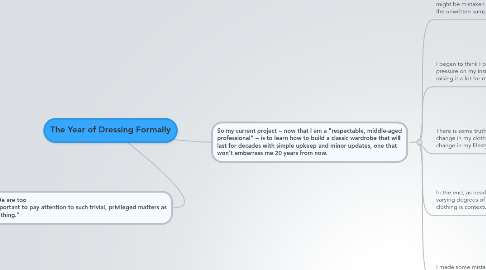
1. So my current project -- now that I am a "respectable, middle-aged professional" -- is to learn how to build a classic wardrobe that will last for decades with simple upkeep and minor updates, one that won't embarrass me 20 years from now.
1.1. If one dresses too formally at my college -- or most colleges -- one might be mistaken for an administrator, which is a clear violation of the unwritten sumptuary laws
1.1.1. And I did find more students holding doors for me and calling me "sir" as if I were a person of importance
1.2. I began to think I could exert some pressure on my institution to raise the bar of formality a little by raising it a lot for myself
1.2.1. In the process, I probably irritated some of my colleagues, a few of whom are aggressively informal on principle: denim, work boots, sandals -- anything goes but formality.
1.2.2. Although it got out of hand, I think my year of dressing formally was a worthwhile experiment.
1.2.2.1. But I found that a higher level of formality improved my students' learning. My larger classes ran more smoothly. I had fewer disruptions, less chatter, more notetaking.
1.2.2.2. The unexpected softness of my appearance in my office seemed to cause students to open up and speak more honestly of their difficulties and aspirations.
1.3. There is some truth to that criticism. After a while, the dramatic change in my clothing began to make larger demands for a complete change in my lifestyle
1.3.1. I started to covet glass and steel urban loft apartments, and I began visiting the Web sites of Volvo and Mercedes.
1.4. In the end, as nearly every writer on the subject advised with varying degrees of emphasis, the most important thing about clothing is contextual appropriateness, in addition to quality and fit
1.4.1. And now I have come to rest somewhere between business casual and business formal: I have fewer clothes but the ones I do have are of higher quality, with better tailoring.
1.4.2. Above all, when I dress, I pay careful attention to context, including my age, rank, and the nature of the task at hand, even if that means adjusting my clothes in the middle of the day -- like superman in a phone booth -- as I change from professor to counselor to administrator and back again
1.5. I made some mistakes, particularly regarding the matter of contextual propriety
1.5.1. I progressed rapidly from sport coats to suits and ties
1.5.2. I even experimented for a time with French cuffs and pocket squares.
